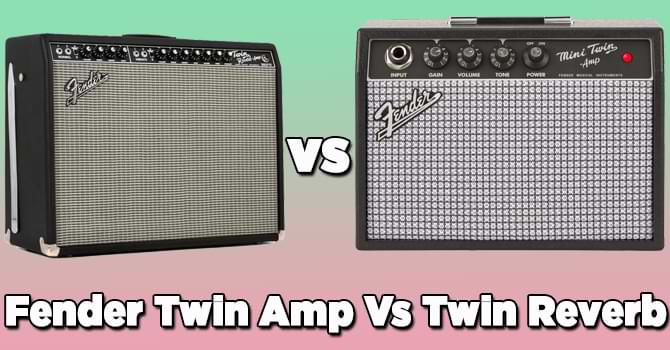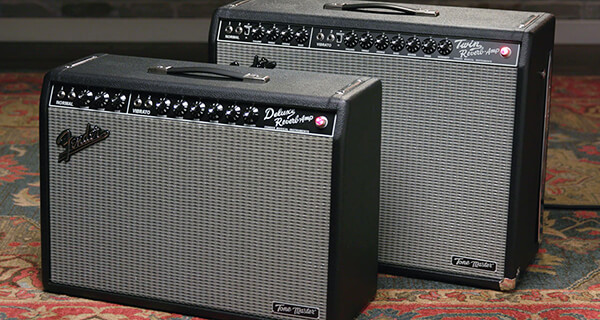Fender Twin Amp Vs Twin Reverb [Difference & Which is Better]
In the world of iconic guitar amplifiers, the Fender Twin Amp vs Twin Reverb hold revered positions. These amplifiers, known for their clean tones and versatility, have left an indelible mark on music history. This in-depth comparison explores the differences between the two, covering aspects like sound, tone shaping, speakers, portability, footswitch capabilities, and tube configurations. Whether you’re a performing musician seeking the perfect amp or a curious enthusiast, this guide provides valuable insights for making an informed choice.

# Table of Contents =>
- 1 Main Difference Between The Fender Twin Amp Vs Twin Reverb:
Comparison Table:
| Features – | Fender Twin Amp | Fender Twin Reverb |
|---|---|---|
| Amplifier Type | Tube (Valve) Amplifier | Tube (Valve) Amplifier |
| Wattage | 100 watts | 85 watts (Silverface) or 80 watts (Blackface) |
| Speaker Configuration | 2 x 12-inch speakers | 2 x 12-inch speakers |
| Channels | 2 (Clean and Overdrive) | 2 (Normal and Vibrato) |
| Controls | Separate EQ for each channel, Reverb, Presence, Master Volume, Gain, and more | Separate EQ for each channel, Reverb, Vibrato Speed and Intensity, Bright Switch, and more |
| Reverb | Spring Reverb with Level control | Spring Reverb with Dwell and Mix controls |
| Effects Loop | Yes | Yes |
| Footswitch | Included | Included |
| Weight | Approximately 64 lbs (29 kg) | Approximately 64 lbs (29 kg) |
| Dimensions | 26.5″ x 11.25″ x 19.87″ (67.3 x 28.6 x 50.5 cm) | 26.5″ x 10.5″ x 21.1″ (67.3 x 26.7 x 53.6 cm) |
| Tone | Versatile, capable of clean and over-driven tones | Known for its iconic clean and sparkling tones |
| Best Suited For | Rock, Blues, and Classic Rock genres where overdrive is desired | Clean tones, Jazz, Country, and genres requiring crystal-clear clean sounds |
| Price Range (approx.) | Varies (used models available) | Varies (used models available) |
Overview of the Fender Twin Amp –
The Fender Twin Amp has held a prominent position in Fender’s amplifier range ever since it made its debut in the 1950s. Recognized for its remarkable headroom and potent performance, the Twin Amp stands as a 2-channel tube amplifier that garners admiration from both aficionados of pristine clean tones and pedal board enthusiasts.
Key Features:
Wattage: The Fender Twin Amp is available in various wattage options, with the most common being 100 watts. This sheer power allows for pristine clean tones even at high volumes.
Channels: It features two channels – Normal and Vibrato. The Normal channel is known for its crystal-clear clean tones, while the Vibrato channel adds a lush, modulated effect.
Tone Stack: The Twin Amp sports a classic Fender tone stack with Treble, Mid, and Bass controls, offering a great deal of tonal control.
Reverb: It typically includes tube-driven spring reverb, which adds a rich spatial dimension to your sound.
Speaker Configuration: The speaker configuration may vary based on the specific model, offering options of either a 2×12″ or 4×12″ setup.
Overview of the Fender Twin Reverb –
The Fender Twin Reverb stands as another iconic amplifier that has left an indelible imprint on the music industry. Much like the Twin Amp, it embodies the quintessential tube amplifier, revered for its luxurious clean tones, and cherished by numerous renowned musicians.
Key Features:
Wattage: The Fender Twin Reverb is commonly available in 85 to 100-watt versions, delivering ample headroom for clean tones.
Channels: It usually features two channels – Normal and Vibrato, similar to the Twin Amp. The Normal channel is renowned for its clean, pure sound.
Tone Stack: The Twin Reverb shares the classic Fender tone stack with Treble, Mid, and Bass controls.
Reverb and Tremolo: What sets the Twin Reverb apart is its built-in spring reverb and tremolo effect, which adds depth and modulation to your sound.
Speaker Configuration: It typically comes with a 2×12″ speaker configuration.
Main Difference Between The Fender Twin Amp Vs Twin Reverb:
a) Sound Quality –

The Fender Twin Amp is celebrated for its exceptional headroom, positioning it as the perfect selection for guitarists in search of immaculate, untarnished clean tones, even when cranked to high volumes. Its 2×12″ or 4×12″ speaker configuration expands the sonic landscape, rendering it exceptionally well-suited for live performances where projecting sound is of paramount importance.
The Twin Amp’s clean channel is transparent and ideal for pedal enthusiasts who want their effects to shine through without any coloration from the amp itself. While it can take pedals exceptionally well, it may lack some of the lush reverb and tremolo effects found in the Twin Reverb.
The Fender Twin Reverb is celebrated for its lush and spacious clean tones, thanks to its built-in spring reverb and tremolo. The onboard reverb is a hallmark of the Twin Reverb sound, creating a sense of depth and ambiance that’s hard to replicate with external pedals alone.
The Twin Reverb’s clean channel, like that of the Twin Amp, is crystal clear and works beautifully with pedals. However, the inclusion of reverb and tremolo on the amp itself adds a layer of convenience and a unique character to the sound.
In summary, if you prioritize pristine clean tones with the option to add pedals, the Twin Amp might be your choice. However, if you want the convenience of built-in reverb and tremolo for a more immersive clean tone experience, the Twin Reverb has the edge.
b) Tone Sculpting and Speaker Size –
Both the Fender Twin Amp and the Fender Twin Reverb offer extensive tone sculpting options through their classic Fender tone stacks. However, there are differences in their speaker configurations that impact the overall tonal characteristics.
Fender Twin Amp Tone Sculpting and Speaker Size:
2×12″ Configuration: The 2×12″ speaker configuration delivers a harmonious sound profile characterized by its expansive frequency response. This makes it an optimal selection for guitarists seeking a harmonious blend of clarity and warmth in their tone.
4×12″ Configuration: If you opt for the 4×12″ version, you’ll experience even more pronounced projection and a fuller sound. This is a great choice for players who need their sound to fill large venues.
Fender Twin Reverb Tone Sculpting and Speaker Size:
Like the Twin Amp, the Twin Reverb boasts a versatile tone stack with Treble, Mid, and Bass controls. However, it’s the built-in reverb that truly sets it apart in terms of tone sculpting options.
2×12″ Configuration: The Twin Reverb’s 2×12″ speaker configuration delivers a clean and balanced sound. The presence of two 12″ speakers helps in achieving a full sound with excellent clarity.
In terms of tone sculpting, both amplifiers offer similar control over your sound. The choice between them may come down to whether you prefer the added dimension of built-in reverb and tremolo (Twin Reverb) or the flexibility to shape your sound with external effects (Twin Amp).
c) Weight and Portability –

When it comes to gigging and touring, the weight and portability of your amplifier can be a critical factor to consider.
The Twin Amp, particularly in its 4×12″ speaker configuration, is a substantial amplifier in terms of weight. It can be challenging to transport, especially if you’re a gigging musician who needs to move equipment frequently. However, the 2×12″ version is somewhat more manageable.
The Twin Reverb, featuring a 2×12″ speaker configuration, remains a somewhat weighty amplifier. While it doesn’t reach the heft of the 4×12″ Twin Amp, it’s a factor worth pondering if you anticipate frequent gear transportation.
On the whole, neither of these amplifiers boasts a reputation for being lightweight in design. Hence, it’s imperative to carefully evaluate your individual portability requirements before reaching a verdict.
d) Footswitch Functionality –
Footswitch functionality can greatly enhance your performance by allowing you to control various features of your amplifier without having to reach down and make manual adjustments.
The Twin Amp typically comes with a footswitch that allows you to switch between the Normal and Vibrato channels. This is useful if you want to transition between clean and slightly modulated tones seamlessly.
The Twin Reverb frequently comes equipped with a footswitch that offers more than just channel switching. It also empowers you to manage the onboard reverb and tremolo effects effortlessly. This degree of command can be priceless in a live performance context, facilitating swift addition or removal of effects as needed.
If you value the convenience of controlling built-in effects with a footswitch, the Twin Reverb’s functionality may be more appealing.
e) Amp Tubes –
The Twin Amp typically uses a combination of 6L6 power tubes and 12AX7 preamp tubes. This tube configuration contributes to its clean headroom and transparent sound.
The Twin Reverb also utilizes 6L6 power tubes, which deliver ample power and clean tones. The choice of preamp tubes may vary between different models, but 12AX7 tubes are commonly found in the preamp section.
Both amplifiers benefit from the characteristics of these tube types, offering rich and dynamic clean tones that respond well to your playing dynamics.
Which is Better for Performance?
Now that we’ve explored the differences between the Fender Twin Amp and the Fender Twin Reverb in terms of sound, tone sculpting, speaker size, weight, portability, footswitch functionality, and amp tubes. It’s time to consider which one might be better for your performance needs.
Choose the Fender Twin Amp if:
- You prioritize pristine clean tones and plan to use external effects pedals to shape your sound.
- You need the flexibility to switch between multiple wattage options, including high-power settings.
- Weight and portability are not major concerns for your gigging setup.
Choose the Fender Twin Reverb if:
- You want the convenience of built-in spring reverb and tremolo effects, which can add depth and modulation to your sound.
- Footswitch functionality for controlling reverb and tremolo during live performances is important to you.
- You’re comfortable with the weight and portability of a 2×12″ speaker configuration.
Conclusion:
In the Fender Twin Amp vs Twin Reverb debate, there’s no definitive winner—only choices that align with your preferences. The Twin Amp suits those who prioritize clean tones and pedal board versatility. While the Twin Reverb appeals to those who crave built-in effects & footswitch control.
Both amplifiers offer classic Fender tones, making your decision a matter of artistic vision and practicality. Whichever you choose, you’re embracing a legacy that has inspired generations of guitarists worldwide.
Also Read: Orange Rocker 15 Vs Marshall Origin 20 [Difference]
Last Updated on August 21, 2025 by Perry Garner


